- Meet & Greet By Our Team at Hosea Kutako International Airport
- Transfer from Hosea Kutako Int. Airport to Omaanda Lodge, Zannier Game Reserve
- Arrival and Check-in at Omaanda Lodge, Zannier Game Reserve
- Sunset Conservation Drive in the Zannier Game Reserve
- Dinner at Omaanda Lodge
Situated just 30 minutes out of Windhoek and 20 minutes from the Windhoek International Airport, yet relaxing at the pool or post massage, with the savanna plains of the Khomas Hochland ahead of you, you'd never think you were even remotely close to either. So far removed as a destination on its own - not just for the property but for the offering by Zannier Hotels in all.
The vista from the lodge usually includes blue skies dotted with white clouds, bustling warthog families at the watering hole, giraffes.



Windhoek, which is the capital and largest city of Namibia is located in central Namibia in the Khomas Highland plateau area, at around 1,700m (5,600 ft) above sea level and is almost exactly at the country's geographical centre. Your guide will familiarize you regarding the area and provide all crucial information.
Windhoek has developed at the site of a permanent hot spring known to the indigenous pastoral communities. It developed rapidly after Jonker Afrikaner, Captain of the Orlam tribe, settled here in 1840 and built a stone church for his community.
Namibian Culture and etiquette:
Greetings are key to ensuring good social relations in Namibia, as in many parts of Africa. Before you ask a question or a favour, you should always make sure you greet the person and enquire after their health. If you can manage that in the relevant local language, then so much the better. Handshakes are the most common form of greeting, especially among men, and always with the right hand. Men will often use the three-part African handshake when greeting other men. Women are more likely to greet each other and men with words, though they may shake hands. If in a more traditional rural setting, a small nod, bow or curtsy may be given by the junior to acknowledge seniority.
Photography is a thorny area, which has been badly handled by many tourists over a number of years, especially with regards to the Himba, Herero and the San, where taking photos tends to dominate interactions to a worrying extent. The crass behaviour of some tourists who snap away without permission of the individuals concerned and with minimal interaction with them has led to difficult relations between some Namibian communities and tourists. Some Himba and Herero women in particular are now demanding payment for having their photo taken. Always ask permission if you wish to take a photo, and only after you have spent time in meaningful interaction with the person or people concerned.
Modest dress is also important, especially when visiting rural areas, which are generally dominated by Christian conservatism. In the extreme heat it may be tempting to strip off to the bare essentials, but notwithstanding the risk of sunburn, short, skimpy attire is fine for the beach but can give offence in villages.There is generally a high level of press freedom in Namibia, particularly in the print media.
The country’s top newspaper, both in quality and circulation, is the mainly English-language (with some content in Oshiwambo) daily The Namibian. The New Era is the state-owned daily paper. Several other dailies exist, including ones in Afrikaans and German, as well as several weekly papers and monthly magazines. There are over twenty private and community-owned radio stations, as well as the ten channels in different languages operated by the government-owned Namibian Broadcasting Corporation (NBC).
- Dinner, Bed & Breakfast
- Meet & Greet
- Airport Transfer
- Zannier Game Reserve Conservation Drive
- Bottled Still Water
International flights
Regional & Domestic flights
Insurance for lost luggage, cancellation, medical repatriation, visas...
Extra activities not displaying in this itinerary or marked by the symbol "Not Incl."
Drinks, tips, curios etc...
- Breakfast & Transfer from Omaanda Lodge, Zannier Game Reserve to Andersons at Ongava
- Arrival and Check-in at Andersons at Ongava, Ongava Private Game Reserve
- Sunset Game Drive in Ongava Private Game Reserve
- Dinner at Andersons at Ongava
Andersson's Camp is situated in the private Ongava Reserve bordering the famous Etosha National Park. Named after the Swedish explorer Charles John Andersson, Anderssons At Ongava is at the gate of the famous Etosha National Park, and offers a very private safari experience with only seven double rooms and one family room. A reinvention of the original camp, Andersson’s at Ongava invites travellers to expand the parameters of a Namibian safari.
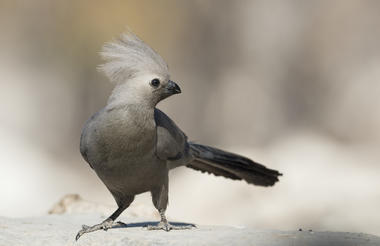
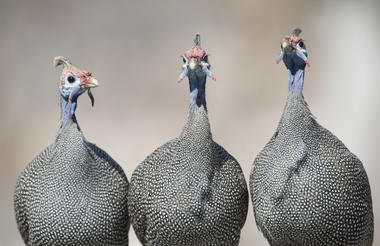
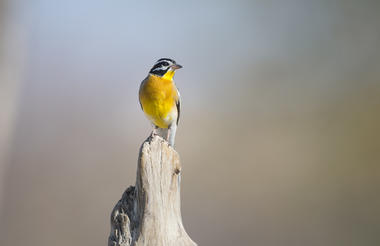
The Etosha National Park is one of the most important nature reserves in southern Africa. It exists since 1907 and covers an area of 22,270 km². The central and eastern sections consist mainly of various silvery-white shining salt pans, which have made Etosha famous. In the dry season the park, the animals and the vehicles are covered in a whitish haze of salt dust.
Ongava Private Game Reserve remains one of the few reserves in southern Africa where visitors will have the chance to see both Black and White Rhino as well as the opportunity to track White Rhino on foot with an experienced guide. The reserve also offers bird watching, 4x4 guided game drives and guided game walks. With plenty of waterholes on site, the wildlife activity is endless, so be sure to have your camera equipment on standby!
- Fully Inclusive
- Bottled Still Water
International flights
Regional flights
Insurance for lost luggage, cancellation, medical repatriation, visas...
Extra activities not displaying in this itinerary or marked by the symbol "Not Incl."
Drinks, tips, curios etc...
Breakfast & Full Day Game Drive in Etosha National Park
Lunch in Etosha National Park
Dinner at Andersons at Ongava
You'll start early this morning with a safari guide for your game drive to look for your favourite animals today, as you'll be on route to see and learn about as much of the free roaming wildlife in this area as you can. The Etosha National Park is famous for African elephant, lion, leopard, hyena, rhino, and other antelope sightings, offering a very pleasant experience, especially to first timers in the part. The waterholes at clearly marked and the maps of the park are very clear. Today's route will take you throughout most of the southern and western parts of the Etosha National Park.
In the dry season, Etosha National Park has excellent viewing in the heat of the day – a fairly unique phenomenon thanks to the abundance of waterholes. Vast herds of zebra, springbok, impala and oryx are joined by ostriches, giraffe and elephants trying to cool down and quench their thirst.
You do not get to our accommodation until late in the afternoon, and just in time for another delicious dinner.

The Etosha National Park is famous for African elephant, lion, leopard, hyena, rhino, and other antelope sightings, offering a very pleasant experience, especially to first timers in the part. The waterholes at clearly marked and the maps of the park are very clear and simple to follow.
WHAT TO EXPECT ON A GAME DRIVE:
Every game drive is different – which keeps things exciting – but the format of a game drive is likely to be quite similar, wherever you are:
The time of day will usually be early mornings, late afternoon or at night – the coolest times of the day when most animals are more active.
With the length and distance will vary, game drives last around 3 to 4 hours, and will include a break.
With luck you’ll see a mix of different wildlife sightings, with stops to take in and photograph each animal
type.
You should get plenty of conversation with your tour guide to learn about the animals you see, plus lots of
other related info about the habitat, plants, birds, animal tracking, and if you’re lucky, the occasional
amazing animal story or two.
A break where you can get out of the vehicle and have a drink and a snack – usually somewhere with a great
view of wildlife and/or the bush. On morning drives you’ll likely have a hot drink, and afternoon drives warrant something a little colder. Unbeatable!
SOME PACKING ESSENTIALS FOR ETOSHA NATIONAL PARK:
Headtorch – Required for your overnight camping in Etosha, you will require a headlamp or portable lamp of some sort. Consider a good LED option.
Good Camera – Etosha is one of those ultimate bucket list destinations in Africa and travelling here with a good camera will help you preserve the memories. A light, compact and robust camera is recommended.
Sun Hat, Sunscreen & Sunglasses – Namibia is hot all year round, with some crazy strong UV rays, so making sure you pack a sunhat, sunscreen & sunglasses for adequate protection is key.
Insect Repellent – Malaria is a low risk in Etosha National Park, however, be sure to cover up at night and use at least a 30% DEET repellent.
Sarong – Whether it’s for covering your shoulders from the sun, using as a sheet when camping or as a towel after your shower, a sarong is a great multi-purpose travel item to bring here.
A beautiful African sunset in the bush is always a wonderful sight. Etosha has two seasons. The wet season runs from November to May and the dry season from June to October. In the wet season the land is green and lush, vegetation thick and roads muddy. The animals spread out over the wide plains and disappear into the bushy shrub. Some roads are closed and driving becomes trickier.
The dry season forces animals to congregate around waterholes. As zebra, springbok and impala gather to cool off and quench their thirst, opportunistic lions and cheetahs take advantage of knowing where their prey is going to be. This creates the perfect environment for great game viewing.
The vast majority of the driving in Etosha is on gravel tracks. Most are relatively straightforward and easy to drive on but some can become rutted, making journeys a bit slower.
- Fully Inclusive
- Full Day Game Drive in Etosha National Park
- Bottled Still Water
International flights
Regional flights
Insurance for lost luggage, cancellation, medical repatriation, visas...
Extra activities not displaying in this itinerary or marked by the symbol "Not Incl."
Drinks, tips, curios etc...
- Breakfast & Air Transfer from Andersons at Ongava to Hoanib Skeleton Coast Camp, Kaokoland
- Arrival and Check-in at Hoanib Skeleton Coast Camp, Kaokoland
- Sunset Nature Drive in Hoanib River
- Dinner at Hoanib Skeleton Coast Camp
Located in Namibia’s remote northwest within the astounding landscapes of the Kaokoveld, Hoanib Skeleton Coast Camp offers a slice of luxury amid towering mountains, sand dunes and vast expanses of desert, and is in one of Namibia’s most remote and untouched wilderness areas. This unique wilderness is home to desert-adapted wildlife and fascinating, nomadic Himba tribes.
At Wilderness Hoanib Skeleton Coast Camp eight pale olive, generously appointed, tented suites peak like whitecaps on an ocean of sand. Totally solar-powered, their open design and colour palette reflect the surrounding desert. A unique experience beckons for the intrepid traveller seeking chic luxury in a startlingly rugged and isolated, ancient landscape.
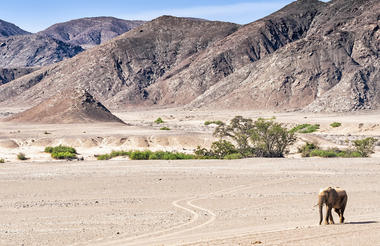
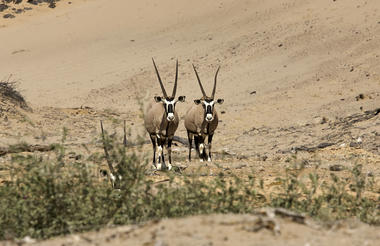
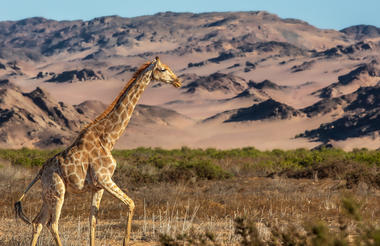
Hoanib (meaning ‘place of elephants’) is very different in design from any other camp in Namibia, with a chic feel that is quite removed from the traditional safari-style camp. That said, the main focus here is firmly on the experience and activities rather than on the camp itself.
The area is also home to some of Namibia’s last remaining desert lion, made famous by several documentaries, books and long-running research projects. Nature walks, usually close to camp, offer the chance to step out of the vehicle and take a walk through the wilderness with a guide – and perhaps a sundowner drink.
Much has been written about a pride of desert lions from this area, affectionately known as the ‘musketeers’ from the film Vanishing Kings. We were incredibly lucky to see four of the five lions lazing around in the Hoanib River eyeing up passing prey.
- Fully Inclusive
- Domestic Air Transfer
- Sunset Nature Drive
- Bottled Still Water
International flights
Regional flights
Insurance for lost luggage, cancellation, medical repatriation, visas...
Extra activities not displaying in this itinerary or marked by the symbol "Not Incl."
Drinks, tips, curios etc...
Breakfast & Activities at Hoanib Skeleton Coast Camp
Dinner at Hoanib Skeleton Coast Camp
The Skeleton Coast is well named; it is wild and desolate, however offers one of the most magnificent locations on the planet.
The Hoanib is known to be one of the best wildlife areas in Namibia outside Etosha National Park. Giraffes and Oryx are often seen. Desert adapted elephants search the river beds for water, usually the big bulls but entire elephant herds are seen as well. Cheetahs are also present and the elusive brown hyenas frequent the area too.
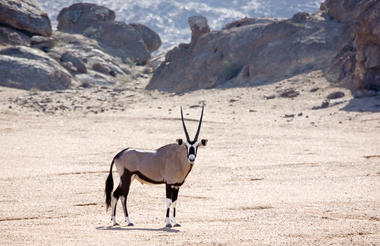
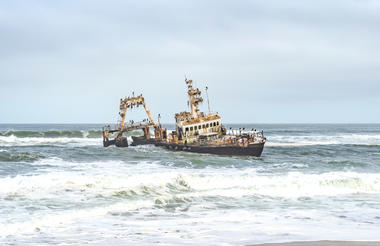
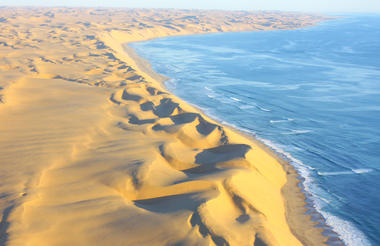
Activities from Hoanib Skeleton Coast Camp include morning and afternoon 4WD drives – either scenic or for wildlife viewing; nature walks where you can learn close up about the smaller animals and insects as plants, and full-day trips to Klein Oase, and Auses and Mudorib springs (which attract desert-adapted elephant and plenty of birds). Because it can get pretty cold in this area, all drives are taken in closed eight-seater 4WDs with a pop-top roof.
The camp’s proximity to the Skeleton Coast National Park affords guests great access to this remote and inhospitable part of Namibia. Very few people get to visit this unique park, an area of vast dunes fields, gravel plains with delicate lichen fields, windswept beaches, Cape fur seals and remnants of shipwrecks, and.Hoanib Skeleton Coast Camp is the very best base from which to explore.
Nature drives showcase the magnitude of the landscape and offer the best possibilities of seeing desert-adapted wildlife.
Day trips to Klein Oase and Auses Spring can be organised. These oases are a fascinating respite from the dry surrounds of the desert and offer the chance of seeing wildlife coming to drink as well as plenty of birdlife. These full-day trips are done in our semi-closed game drive vehicles, with a stop for a picnic at a scenic spot along the way.
- Fully Inclusive
- Activities at Hoanib Skeleton Coast Camp
- Bottled Still Water
International flights
Regional flights
Insurance for lost luggage, cancellation, medical repatriation, visas...
Extra activities not displaying in this itinerary or marked by the symbol "Not Incl."
Drinks, tips, curios etc...
Breakfast & Air Transfer from Hoanib Skeleton Coast Camp to Little Kulala Desert Lodge, Sossusvlei Area
Arrival and downtime at Little Kulala Desert Lodge
Dinner at Little Kulala Desert Lodge
You'll enjoy a birds-eyed view of the Namib Naukluft National park. The Naukluft Park is one of the largest parks in Africa and the world at over 49,000km² (19,000sq miles), a little larger than Switzerland to put things into better perspective. The park is home to various species of wildlife, but more specially, the Hartmann Mountain Zebra which roam freely through the vast plains and mountains of this area. The Namib Naukluft Park also contains some of the most iconic attractions of the country, like the towering sand dunes of Sossusvlei.
Other attractions include the desert adapted vegetation of the area, like the Succulent Karoo, Camel-thorn Acacia, Lichens and many more. A wonderful sunset and a wonderful dinner is something to look forward to this evening.
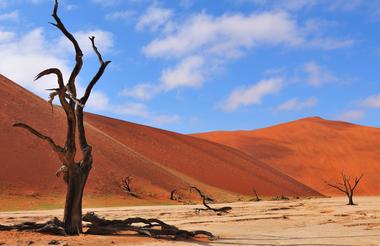
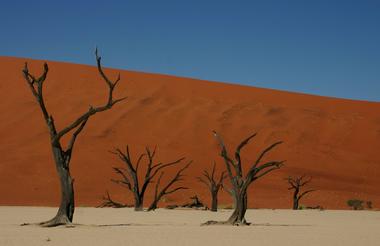
The dunes are best visited in the morning or later afternoon. At this time, the colour is more vibrant, the heat is less oppressive, and the crowds are diminished. At times, you’ll feel like the dunes are all yours to explore, so make the most of it. Hike (or try) to the top of one and admire the Mars-like landscape from above - it’s incredible.
Probably the most famous and photographed dune in Sossusvlei, Dune 45 is easily accessible; it lies 45km from Sesriem, just off the paved road.
Like most great attractions around the world, it’s possible to go ballooning over the dunes of Sossusvlei. Flights depart before sunrise, where you’ll be treated to an epic live show of mother natures beauty.
- Fully Inclusive
- Bottled Still Water
International flights
Regional flights
Insurance for lost luggage, cancellation, medical repatriation, visas...
Extra activities not displaying in this itinerary or marked by the symbol "Not Incl."
Drinks, tips, curios etc...
Hot Air Ballooning Activity
Sesriem to Deadvlei
Deadvlei excursion
Sesriem Canyon excursion
Dinner at Sossusvlei Lodge
A pre-dawn start is a must this morning in order to appreciate the wonders that this area has on offer. The morning will start with a Hot Air Ballooning Activity over the dunes of the Namib Desert.
Sossusvlei is the very end of the Tsauchab River, approximately 55km from the Atlantic Ocean, which on rare occasions turns into a true water filled oasis after heavy rainfall. This phenomena has not been evident for the last few years, as this area is predominantly bone-dry throughout the year averaging around 20mm of rainfall per annum.
You'll return to the lodge just before noon in order to enjoy some lunch, and enjoy some pool time. Another activity is the visit to the Sesriem Canyon, before enjoying another scrumptious dinner at the lodge.
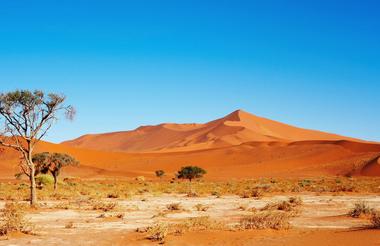
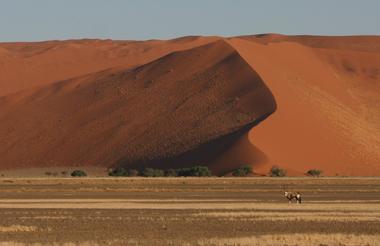
You'll enter Sossusvlei at sunrise in the morning and remember to take plenty of water, sun cream, a hat, walking shoes, camera batteries and film/memory. Explore some of the world's highest dunes and a sheltered pan with petrified trees that are hundreds of years old; climb the dunes and look out over at the sandsea. Private reserves in the area reveal fascinating flora, fauna and ancient desert landscapes.
Other attractions in close proximity to Sossusvlei include Sesriem Canyon, Dune 45, Hiddenvlei, Big Daddy and Deadvlei. All of these attractions can be accessed from the road that takes you to Sossusvlei, and are all well worth a visit. In a number of areas surrounding Sossuvlei look out for the petrified dunes.
The Sossusvlei area offers visitors some of the picturesque and indescribable landscapes in the world, with unbelievable colour contrasts at sunrise and after sunset along with amazing photographic opportunities. Here we will also look at the abundance of small life, which baffles the mind as to how the numerous creatures can survive in this harsh and unforgiving Namib desert.
- Fully Inclusive
- Sossusvlei National Park entrance and park fees
- Hot Air Ballooning
- Deadvlei excursion
- Sesriem Canyon excursion
- Bottled Still Water
International flights
Regional flights
Insurance for lost luggage, cancellation, medical repatriation, visas...
Extra activities not displaying in this itinerary or marked by the symbol "Not Incl."
Drinks, tips, curios etc...
- Transfer from Little Kulala Desert Lodge to Hosea Kutako International Airport.
Today you have reached the end of your journey and head back to the Windhoek Airport .
The Common Wanderer:
'A little known fact is that Namibia has the second lowest population density in the world after Mongolia, with only 2.2 million inhabitants. It’s immensely vast, yet so completely empty. In fact, on one day, we spent several hours driving through the Namib desert without seeing another living soul - not even an animal. The isolation has its perks though; we found Namibia to be the perfect place to escape the hustle and bustle of city life, and embrace a quieter way of living.'
A few tips which will make your long haul flights a little more comfortable:
1. Dress Comfortably
Flying is one of those things where you need to prioritize comfort over everything else. Especially on flights that are in the 10+ hour range. One easy way to make your flight more comfortable is to wear the right kind of clothes. Tracksuits, leggings, cotton t-shirts, hoodies and lightweight sweaters are all great options.
2. Pack Snacks
Let's face it. Airplane meals are nothing like what your mother used to make! Especially if you're flying economy. They're usually far from the healthiest option, let alone tastiest, so your best bet is to pack your own snacks.
3. Always Bring Entertainment
If you're anything like me, then you don't just want to pass the time on a long flight, you want it to go by as fast as possible. This means that you will need an activity that you find both fun and engaging.
Whether it's watching three movies in a row, binge-watching an entire season on Netflix, or devouring a good book - make sure that you have enough options to keep you entertained for the length of your flight.
4. Consider Noise Cancelling Headphones
The difference between a nightmare flight, and one you enjoy, can be as simple as bringing noise-canceling headphones. Even though some airlines will distribute earphones for free, they're usually cheap and nasty and not great at drowning out the background noise.
5. Hydrate Your Skin Too
The pressurized air inside the cabin is incredibly dry and it's not great for your skin. After a long flight, it might even feel like you washed your face with sandpaper.
Prepare yourself for that - bring a moisturizer on the flight and maybe even a sheet mask if you can. Lip balm is also a good idea because your lips will dry out far sooner than your face. Just make sure that the moisturizer you decide to bring is in accordance with the TSA rules - meaning, it needs to be in packaging of 100ml (3 ounces) or less.
6. Don't Wear Contacts
I can't stress this one enough - wearing glasses instead of contact lenses on a flight. This can be the difference between a relaxing flight, and having to rush to the optometrist as soon as you land. The dry air inside the cabin will dry up your contact lenses, often causing them to stick to your eyes. Not only is this really uncomfortable, imagine what happens when you try to remove them afterwards!
7. Maintain Personal Hygiene
Making yourself even a little more comfortable on a long flight can be as simple as freshening up mid-flight.
8. Wear Compression Socks
Compression socks help regulate the blood flow in your legs, and they are particularly useful on longer flights. Especially if you usually have issues with swelling in your feet or ankles.
9. Organize Your Daypack
When you get to the airport you have one important goal - board the plane as quickly and as efficiently as possible. And, if you act like a headless chicken when you reach the TSA checkpoint, you've not only failed yourself but potentially made yourself a target for a special security check.
That's why you want to organize your daypack (or carry on) down to the very last detail, instead of just throwing everything inside. Remember, when you get to the security checkpoint you'll have to take out your laptop and toiletries. So, put those somewhere easy to reach and not at the bottom of the bag.
10. Move Around on Layovers
The biggest mistake you can make on a layover is sit in the lounge and stare at your phone. Take the opportunity to stretch, walk around, and maybe even light exercise if it's possible. Do anything you can to get the blood flowing. You can sit again once you board the plane again. Now is the time to move.
- Bed & Breakfast
- Domestic Air Transfer
- Bottled Still Water
International flights
Regional flights
Insurance for lost luggage, cancellation, medical repatriation, visas...
Extra activities not displaying in this itinerary or marked by the symbol "Not Incl."
Drinks, tips, curios etc...




